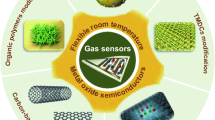Abstract
Polyaniline-metal oxide (TiO2/SnO2) organic–inorganic hybrid materials films were fabricated in situ on a printed circuit board (PCB) via drop coating technique. The mixture of aniline and metal oxide (TiO2/SnO2) dispersed in ethanol was applied along with an oxidant for the coating process. The formed material films were characterized by Fourier transform infra-red spectroscopy, x-ray diffraction and scanning electron microscopy techniques. The sensor functionality of the prepared films on PCB was investigated individually for the detection of benzene or toluene vapor at room temperature. The promptness of sensor response to analyte vapor and its recovery to air, as well as the concentration-dependent sensor functionality of the hybrid material films were investigated. The film form of hybrid materials has shown much improved sensor efficiency even at ambient air condition compared to the pellet form of the polyaniline-SnO2 hybrid material reported earlier, which sensed the same analytes only in nitrogen atmosphere.
Similar content being viewed by others
References
T. Godish, Air Quality, 2nd ed. (Chelsea, MI: Lewis Publishers, 1991), p. 339.
M. Mabrook and P. Hawkins, Sens. Actuators B 75, 195 (2001).
Z. Rao, L. Liu, J. Xie, and Y. Zeng, Luminescence 23, 163 (2008).
M. Ke, M. Lee, C. Lee, and L. Fu, Sensors 9, 2895 (2009).
R. Leghrib, A. Felten, F. Demoisson, F. Reniers, J.-J. Pireaux, and E. Llobet, Carbon 48, 3477 (2010).
B. Ghaddab, F. Berger, J.B. Sanchez, P. Menini, C. Mavon, P. Yoboue, and V. Potin, Sens. Actuators B 152, 68 (2011).
P.P. Sengupta, S. Barik, and B. Adhikari, Manufact. Proc. 21, 263 (2006).
J.G. Roh, H.R. Hwang, J.B. Yu, J.O. Lim, and J.S. Huh, J. Macromol. Sci. A 39A, 1095 (2002).
G. Anitha and E. Subramanian, Sens. Actuators B 92, 49 (2003).
G. Anitha and E. Subramanian, Sens. Actuators B 107, 605 (2005).
A.K. Srivastava, Sens. Actuators B 96, 24 (2003).
Y. Li, F.-X. Zhao, X.-X. Lian, Y.-L. Zou, Q. Wang, and Q.-J. Zhou, J. Electronic Mater. 45, 3149 (2016).
M. Choudhary, V.N. Mishra, and R. Dwivedi, J. Electron. Mater. 42, 2793 (2013).
M.R. Mohammadi and D.J. Fray, J. Electron. Mater. 43, 3922 (2014).
W. Zeng, T. Liu, and Z. Wang, J. Mater. Chem. 22, 3544 (2012).
D. Lee, J. Jung, J. Lim, J. Huh, and D. Lee, Sens. Actuators B 77, 228 (2001).
L. Geng, Y. Zhao, X. Huang, S. Wang, S. Zhang, and S. Wu, Sens. Actuators B 120, 568 (2007).
L. Geng, Trans. Nonferrous Met. Soc. China 19, s678 (2009).
J. Zhang, S. Wang, M. Xu, Y. Wang, H. Xia, S. Zhang, X. Guo, and S. Wu, J. Phys. Chem. C 113, 1662 (2009).
H. Tai, Y. Jiang, G. Xie, and J. Yu, J. Mater. Sci. Technol. 26, 605 (2010).
Z. Hu, Y. Xie, Y. Wang, L. Mo, Y. Yang, and Z. Zhang, Mater. Chem. Phys. 114, 990 (2009).
K. Dutta and S.K. De, Mater. Lett. 61, 4967 (2007).
N.G. Deshpande, Y.G. Gudage, R. Sharma, J.C. Vyas, J.B. Kim, and Y.P. Lee, Sens. Actuators B 138, 76 (2009).
C. Murugan, E. Subramanian, and D.P. Padiyan, Syn. Met. 192, 106 (2014).
C. Murugan, E. Subramanian, and D.P. Padiyan, Sens. Actuators B 205, 74 (2014).
S. Mridha and D. Basak, Semicond. Sci. Technol. 21, 928 (2006).
E. Subramanian, G. Anitha, and N. Vijayakumar, J. Appl. Polym. 106, 673 (2007).
M. Reka Devi, B. Lawrence, N. Prithvikumaran, and N. Jayakumaran, Int. J. Chemtech. Res. 6, 5400 (2014).
H. Nur, L.I. Misnon, and L. Khengwei, Int. J. Photoenergy 98548, 1 (2007).
M.D. Imisides, R. Jhon, and G.G. Wallace, ChemTech 26, 19 (1996).
E. Subramanian, B. Mercy Leela Jeyarani, C. Murugan, and D. Pathinettam Padiyan, J. Chem. Mater. Res. 5, 129 (2016).
H.R. Hwang, J.G. Roh, D.D. Lee, J.O. Lim, and J.S. Huh, Met. Mater. Int. 9, 287 (2003).
A.D. Rushi, K.P. Datta, P.S. Ghosh, A. Mulchandani, and M.D. Shirsat, J. Phys. Chem. C 118, 24034 (2014).
Author information
Authors and Affiliations
Corresponding author
Rights and permissions
About this article
Cite this article
Subramanian, E., Santhanamari, P. & Murugan, C. Sensor Functionality of Conducting Polyaniline-Metal Oxide (TiO2/SnO2) Hybrid Materials Films toward Benzene and Toluene Vapors at Room Temperature. J. Electron. Mater. 47, 4764–4771 (2018). https://doi.org/10.1007/s11664-018-6338-y
Received:
Accepted:
Published:
Issue Date:
DOI: https://doi.org/10.1007/s11664-018-6338-y




